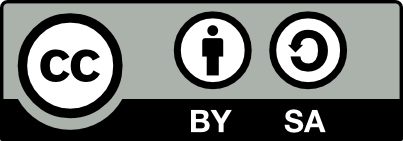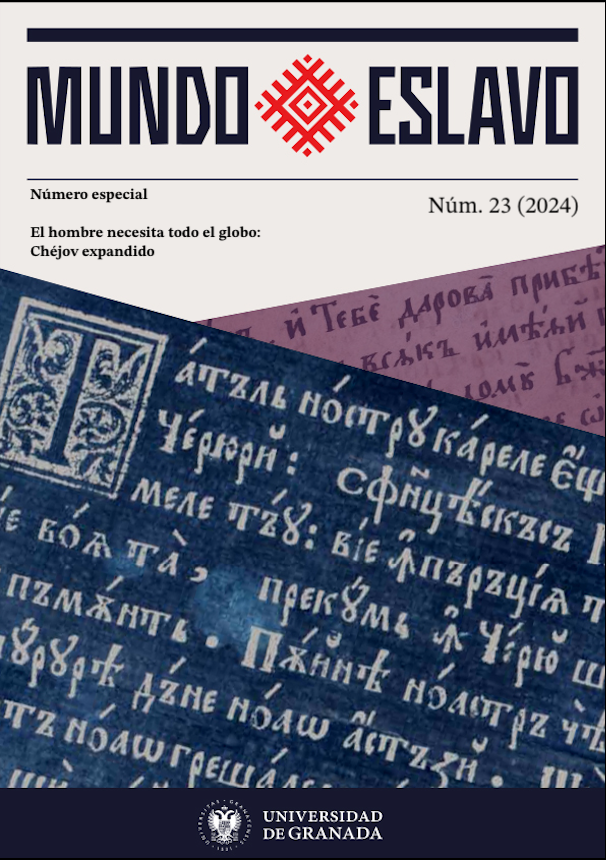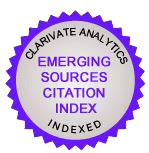Lo fantástico en tensión con lo maravilloso en la obra romántica de Órest Sómov y Nikolái Gógol
DOI:
https://doi.org/10.30827/meslav.23.28820Keywords:
Romanticism, Russian literature, tension, two worlds, marvelous, fantasticAbstract
This paper’s objective is to analyze tension in the first stories of Russian romanticism, represented by the work of Órest Somov and the Gogol of the Ukrainian period, between the marvelous and the fantastic, still in the making. It starts from the assumption that, in this nascent prose, folkloric and religious motifs play a fundamental role and that the limits between the natural and supernatural worlds are still blurred; thus there is no frank confrontation, characteristic of the system of the fantastic.
Downloads
References
Afanas’ev, A. (1994). Pojeticheskie vozzrenija slavjan na prirodu. Indrik.
Bessiere, I. (1974). Le rècit fantastique. Larousse.
Botton, F. (2003). Los juegos fantásticos. UNAM.
Bravo. V. (1985). Los poderes de la ficción: para una interpretación de la literatura fantástica. Monte Ávila Editores.
Campra, R. (2008) Territorios de la ficción: Lo fantástico. Renacimiento.
Castex, P. (1999). Antología del cuento fantástico francés. Corregidor.
Fouqué, C. (2019). Drei Kunstmärchen. (4a ed.). Henricus.
Fouqué,F. (1997).Undine. (9a ed.). Hamburger.
Gógol, N. (1984).Acerca de las canciones de Ucrania. Literatura soviética, (no.4), 155.
Gógol, N. (2020) El carrito y otros cuentos ucranianos. Puertabierta.
Kropotkin, P. (2014). La literatura rusa: Los ideales y la realidad. La Linterna Sorda.
Monforte, R. (2020) Las rusalkas y su presencia en la obra de A. S. Pushkin. En Tras la huella del monstruo femenino, Hermosillo, A. y Rosenberg, A. (eds.). CULAGOS.
Morales, M. (2003). Lo fantástico y sus fronteras. En II Coloquio Internacional de Literatura Fantástica (ed.). BUAP.
Musäus, J. (2013). Volksmärchen der Deutschen. (3a ed.) Offenberg.
Nieto, O. (2015). Teoría general de lo fantástico. UACM.
Pushkin, A. S. (1947). Polnoe sobranie sochinenij v 16 t., t. 2. Izdatel’stvo AN SSSR.
Pushkin, A. S. (1948). Polnoe sobranie sochinenij v 16 t., t. 3. AN SSSR.
Pushkin, A.S. (2007). Izbrannoe. Jeksmo.
Roas, D. (2001). Teorías de lo fantástico. Arco / Libros.
Scott, W. (2021). Acerca de lo sobrenatural en composiciones de ficción, y particularmente en las obras de Ernest Theodore William Hoffmann. UBA.
Sómov, Ó. (2015). La rusalka. En Cuentos fantásticos rusos del siglo XIX (Ariel, A. ed.). Losada.
Somov, O. (2002). Raskaski. Jeksmo.
Somov O. (1823). O romanticheskoj pojezii. Syn” Otechestvo, 71, 8-10.
Tieck, L. (2003).Volksmärchen. (4a ed.).Nicolai.
Todorov, T. (2005). Introducción a la literatura fantástica. Ediciones Coyoacán.
Warner, E. (2005). Mitos rusos. Akal.
Zhukovskij, V. (2009). Rusalka. (7 izd.). Folio.
Афанасьев, A. (1994). Поэтические воззрения славян на природу. Индрик.
Жуковский, В. (2009). Русалка. (7 изд.). Фолио.
Пушкин, А. С. (1947). Полное собрание сочинений в 16 т., т. 2. Издательство АН СССР.
Пушкин, А. С. (1948). Полное собрание сочинений в 16 т., т. 3. АН СССР.
Пушкин, А.С. (2007). Избранное. Эксмо.Сомов, O. (2002). Раскаски. Эксмо.
Сомов О. (1823). О романтической поэзии. Сынъ Отечество, 71, 8-10.
Downloads
Published
How to Cite
Issue
Section
License
Copyright (c) 2024 Mundo Eslavo

This work is licensed under a Creative Commons Attribution-NonCommercial-ShareAlike 4.0 International License.

CC BY-SA: This license allows reusers to distribute, remix, adapt, and build upon the material in any medium or format, so long as attribution is given to the creator. The license allows for commercial use. If you remix, adapt, or build upon the material, you must license the modified material under identical terms.
CC BY-SA includes the following elements:
BY ![]() – Credit must be given to the creator
– Credit must be given to the creator
SA ![]() – Adaptations must be shared under the same terms
– Adaptations must be shared under the same terms
Authors who publish with this journal agree to the following terms:
1. Authors retain copyright and grant the journal right of first publication with the work simultaneously licensed under a Creative Commons Attribution License that allows others to share the work with an acknowledgement of the work's authorship and initial publication in this journal.
2. Authors are able to enter into separate, additional contractual arrangements for the non-exclusive distribution of the journal's published version of the work (e.g., post it to an institutional repository or publish it in a book), with an acknowledgement of its initial publication in this journal.
3. Authors are permitted and encouraged to post their work online (e.g., in institutional repositories or on their website) prior to and during the submission process, as it can lead to productive exchanges, as well as earlier and greater citation of published work (See The Effect of Open Access).













